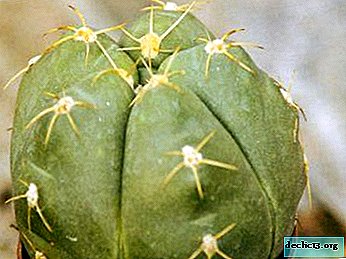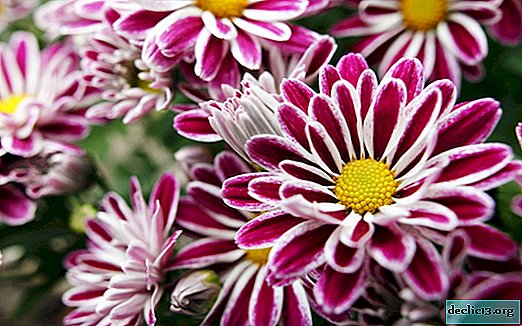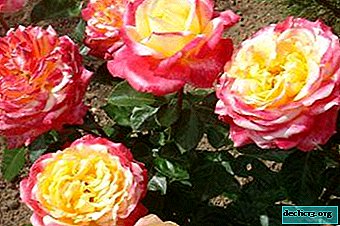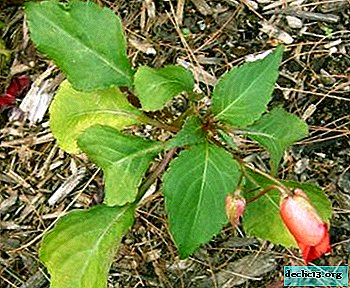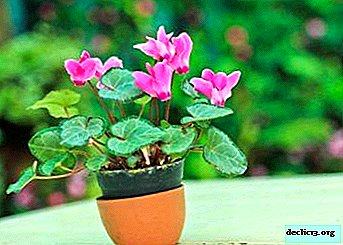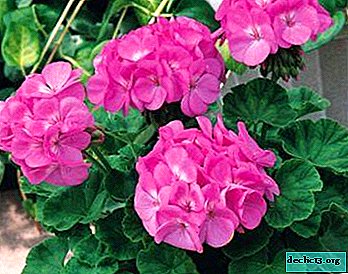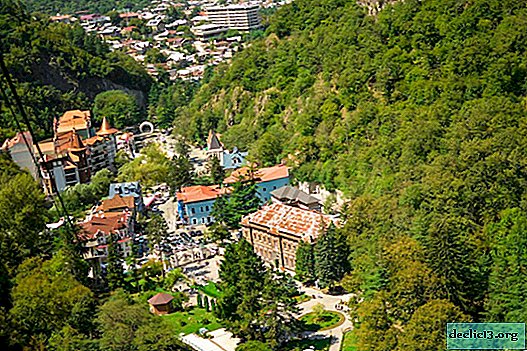Photo and description of Haworthia and its species. Home Care
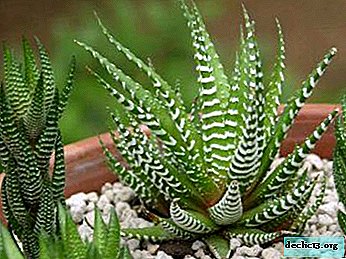 Haworthia is an exotic plant that amateur gardeners around the world go crazy for. Only in Russia has it not yet received widespread distribution. The reason for the unpopularity is obvious, but not true: Haworthy is capricious, and caring for it is fraught with many difficulties. To ruin her, careless growers make serious efforts.
Haworthia is an exotic plant that amateur gardeners around the world go crazy for. Only in Russia has it not yet received widespread distribution. The reason for the unpopularity is obvious, but not true: Haworthy is capricious, and caring for it is fraught with many difficulties. To ruin her, careless growers make serious efforts.
Does it grow well in an apartment? How does it breed? This article provides a detailed description of haworthia and its species.
What kind of flower is this?
Haworthia is a plant from the genus of dwarf and miniature herbaceous succulents and from the Asphodelov subfamily, is a relative of aloe. In vivo, it grows in South Africa.
Reference! The plant was named after the botanist E. Haworth, who determined its place in the classification.Haworthia is an unforgettable plant remotely resembling an exotic cactus. Its leaves are thick and dark green in color. They form rosettes at ground level. Some species have a stem, while others do not. Like cacti, leaves accumulate moisture like tanks: even if it is hot and the grower forgets about her, she will not die.
The edges of the leaf plate are smooth or jagged. Sometimes convex white tubercles are visible on it. Some species produce side shoots. When flowering, ugly white flowers will form on it.
Classification
There are many forms and types of haworthia.
- In the Bayer classification there are about 60 species.
- According to Breyer - 200.
- According to Hayashi - more than 600.
None of the classifications are completed until the end, as new species appear with a sophisticated shape, color and texture.
Views and their photos
Striped

This perennial plant has no trunk. It consists of dense basal rosettes composed of thick lanceolate leaves. A convex strip of white color adorns them below, and the surface is smooth above. The width and length of the leaves are one and a half and five centimeters, respectively.
Drawn

The flower has similarities with the previous species, but it is unattractive. Leaves are decorated with white and green convex points of strictly vertical orientation. The length is seven centimeters with a width of one and a half.
Twisty

Barrel height - 0.15 m. The length of dark green convex leaves with small warts is 2.5 cm.
Sticky

This haworthia reaches a height of 10-20 cm. It has leaves with bent tips. They are small, oval and erect. They are arranged in three rows.
Scaphoid

She has fleshy and shiny leaves. The size of the basal outlet is up to ten centimeters in diameter.
Pearl

She has no stem, and the basal rosette is formed by oval-pointed hard leaves with pearly-white round bulges as a decoration.
Watch a video about Haworthia Pearl:
Chess

This species has thick triangular leaves with denticles along the edges. They are collected in small sockets. On the upper side are light strokes forming a grid. There are warts on the underside.
Attention! There are a lot of species of haworthia, and the ones described above are just some of the most popular among flower growers.Home Care
Even a novice is easy to care for haworthy. The main thing is to follow simple rules regarding watering, fertilizer, lighting and temperature.
Fertilizers
From April to August, the plant is fed with a frequency of once a month. For feeding, fertilizers are used for cacti (Agricola, Good Strength, Forte, etc.), but another breeding scheme is used. Their consistency should be 2 times thinner, i.e. water is added twice as much as indicated on the package. In autumn, you do not need to fertilize haworthia.
Watering
Haworthia is a plant that does not like plentiful watering. If you water it often, allowing stagnation of moisture in the soil, it will die. The optimal frequency of watering is once every five to ten days, so that the soil in the pot is completely dry. After watering, all water is drained from the pan. For irrigation, it is recommended to use settled water. There are no salts in it, which means that nothing threatens the root system.
When watering, water does not get on the central part of the outlet and on the foliage. Otherwise, the plant will rot and die.
Lighting
A pot with a plant is placed on a windowsill well-lit in moderation by direct sunlight. It grows well on a window facing south, but subject to shading during sunshine in spring and summer.
Temperature
With the onset of summer, a pot with a plant is put on a balcony, a loggia or a veranda. Fresh air improves well-being and positively affects growth. Watch the temperature: it should be moderate. In winter, the plant grows well at t = + 10-12⁰C. Watering in winter is minimized - once every four weeks.
Transfer
Haworthia is transplanted and seated if necessary, noticing that in the old pot it is crowded. Young succulents are transplanted once a year, and an adult - every two to three years. Abundant watering before transplantation is not needed.
Priming
Important! In the store, many flower growers buy ready-made soil for cacti, but in this form it is not suitable for transplanting succulents. It is necessary to add fine expanded clay and clay to it, so that the resulting mixture better absorbs excess moisture.If desired, you can prepare the soil yourself by taking:
- 4 hours of sheet land;
- 6 parts of baking powder (expanded clay, fine gravel, pumice, chipped brick, perlite, charcoal or polystyrene).
Pot
Haworthia grows well in a small, short and shallow pot. A large and deep pot is a common cause of root decay and plant death.
Landing
The plant is transplanted or propagated in spring - in March.
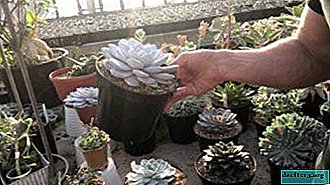 First of all, a container is prepared in which there are already made drainage holes in the bottom, pebbles or pieces of pottery and good soil for succulent are poured.
First of all, a container is prepared in which there are already made drainage holes in the bottom, pebbles or pieces of pottery and good soil for succulent are poured.- In order to remove the plant from the old pot, do not fill it. With the removal there are no problems, but after that you need to carefully examine the roots. Having seen damaged and dry, they are removed, and the places of cuts are treated with charcoal.
- After examining, cutting and processing the roots, the succulent is transplanted into a new pot, carefully compacting the soil in the vicinity of the outlet.
- After transplantation, the Haworthia is watered moderately and only with standing water.
Watch a video about haworthy care at home:
Breeding
Haworthia propagates in several ways. One of these methods is separation with roots when transplanting part of the succulent or cutting off the daughter sockets from the mother plant.
Popular leaf propagation:
- it is cut off;
- dried;
- and then planted in sand or loose soil.
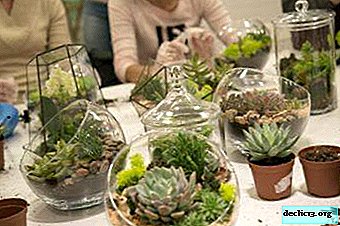 Seeds are planted in small containers with loose soil or wet sand.
Seeds are planted in small containers with loose soil or wet sand.- Do not bury them in the soil.
- The container is placed on a well-lit window sill.
- Shelter with film or glass is useless.
- Seedlings watered with great care.
- After 2-3, you can plant the seedlings in separate pots.
- Hermetically wrap the pot with a film of polyethylene for three days.
- After removing the film, once every 14 days, the foliage is treated with tincture of calendula or ethyl alcohol.
- Once a week for 21 days, it is treated with Aktara, Fitoverm, etc.
Vegetative
Haworthia breeds well by children. The baby is disconnected from the mother plant at the time of transplantation.
Attention! Each baby with or without roots is transplanted into a pot with a suitable moist substrate. If the daughter outlet is transplanted without roots, then rooting will occur in the soil as it grows.Another method of vegetative propagation is by using leaves. The flower grower must choose a healthy leaf, crop or break it. When it dries, and this will happen in 2-3 days, they plant it in a moistened substrate. For a month, the young plant is not watered so as not to interfere with the rooting of the leaf.
Watch the video about the vegetative propagation of haworthia:
Seeds
Amateur growers rarely propagate haworthia seedseven though they are sold in stores. This method is not widespread, because it is complex and inefficient. Seedlings will not look like in the picture on the package with seeds.
You will find all the details about breeding, transplanting and subsequent care of haworthia in this article.
Bloom
Haworthia, although it blooms with small whitish flowers on long peduncles collected in spike-shaped inflorescences, but not all. Flowering in captivity is a rarity.
Important! If it blooms at home, it is better to cut the flower stalk without waiting for the bud to blossom. Otherwise, she will die, having spent all her strength on the formation of the bud.Watch a video about haworthia flowering features:
Diseases and Pests
Haworthia belongs to the category of plants that rarely get sick. Neat succulents are attacked by pests, or rather aphids and root bugs.
Root mealybug is a common cause of redness, yellowing, or leaf shape changes. In advanced cases, white flakes appear on the ground, and a wax coating appears at the edge of the pot.
To cure a plant:
If aphid has struck haworthia, its leaves dry out and curl. Treatment with Actellic or Aktar helps. Treatment involves 3-4 treatments with an interval of ten to twelve days. It is better to alternate insecticides. So that the aphids never hit the plant, they treat it with infusion of onions or tobacco ash every seven days.
Watch a video about succulent pests and methods of dealing with them:
Conclusion
Haworthia is an unpretentious indoor succulent. It is watered as the soil in the pot is completely dry, and fertilized from April to August with fertilizers for cacti. It is also easy to propagate it with sheets or children.

 First of all, a container is prepared in which there are already made drainage holes in the bottom, pebbles or pieces of pottery and good soil for succulent are poured.
First of all, a container is prepared in which there are already made drainage holes in the bottom, pebbles or pieces of pottery and good soil for succulent are poured. Seeds are planted in small containers with loose soil or wet sand.
Seeds are planted in small containers with loose soil or wet sand.
